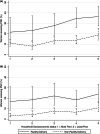Socioeconomic inequity in coverage and quality of maternal postnatal care in Ethiopia
- PMID: 36398859
- PMCID: PMC10108216
- DOI: 10.1111/tmi.13829
Socioeconomic inequity in coverage and quality of maternal postnatal care in Ethiopia
Abstract
Objective: High-quality postnatal care is vital for improving maternal health. This study examined the relationship between household socioeconomic status and both coverage and quality of postnatal care in Ethiopia.
Method: Cross-sectional household survey data were collected in October-November 2013 from 12 zones in 4 regions of Ethiopia. Women reporting a live birth in the 3-24 months prior to the survey were interviewed about the care they received before, during and after delivery and their demographic characteristics. Using mixed effect logistic and linear regression, the associations between household socioeconomic status and receiving postnatal care, location of postnatal care (health facility vs. non-health facility), cadre of person providing care and the number of seven key services (including physical checks and advice) provided at a postnatal visit, were estimated.
Results: A total of 16% (358/2189) of women interviewed reported receiving at least one postnatal care visit within 6 weeks of delivery. Receiving a postnatal care visit was strongly associated with socioeconomic status with women from the highest socioeconomic group having twice the odds of receiving postnatal care compared to women in the poorest quintile (OR [95% CI]: 1.98 [1.29, 3.05]). For each increasing socioeconomic status quintile there was a mean increase of 0.24 postnatal care services provided (95% CI: 0.06-0.43, p = 0.009) among women who did not give birth in a facility. There was no evidence that number of postnatal care services was associated with socioeconomic status for women who gave birth in a facility. There was no evidence that socioeconomic status was associated with the provider or location of postnatal care visits.
Conclusion: Postnatal care in Ethiopia shows evidence of socio-economic inequity in both coverage and quality. This demonstrates the need to focus on quality improvement as well as coverage, particularly among the poorest women who did not deliver in a facility.
Keywords: inequity; maternal health; postnatal care; quality of care.
© 2022 The Authors Tropical Medicine & International Health Published by John Wiley & Sons Ltd.
Figures


References
-
- Li XF, Fortney JA, Kotelchuck M, Glover LH. The postpartum period: the key to maternal mortality. Int J Gynecol Obstet [Internet]. 1996. Jul 1 [cited 2019 Mar 12];54(1):1–10. Available from: https://www.sciencedirect.com/science/article/pii/0020729296026677 - PubMed
-
- Kassebaum NJ, Bertozzi‐Villa A, Coggeshall MS, Shackelford KA, Steiner C, Heuton KR, et al. Global, regional, and national levels and causes of maternal mortality during 1990–2013: a systematic analysis for the Global Burden of Disease Study 2013. Lancet [Internet]. 2014. Sep 13 [cited 2019 Mar 12];384(9947):980–1004. Available from: http://www.ncbi.nlm.nih.gov/pubmed/24797575 - PMC - PubMed
-
- United Nations . The Millennium Development Goals Report [Internet]. 2015. rev (July 1) [cited 2019 Mar 12]. Available from: http://www.un.org/millenniumgoals/2015_MDG_Report/pdf/MDG
-
- United Nations . About the Sustainable Development Goals ‐ United Nations Sustainable Development [Internet]. [cited 2019 Mar 12]. Available from: https://www.un.org/sustainabledevelopment/sustainable‐development‐goals/
-
- Langlois ÉV, Miszkurka M, Zunzunegui MV, Ghaffar A, Ziegler D, Karp I. Inequities in postnatal care in low‐ and middle‐income countries: a systematic review and meta‐analysis. Bull World Health Organ [Internet]. 2015. Apr 1 [cited 2019 Mar 12];93(4):259–270G. Available from: http://www.ncbi.nlm.nih.gov/pubmed/26229190 - PMC - PubMed
Publication types
MeSH terms
LinkOut - more resources
Full Text Sources

